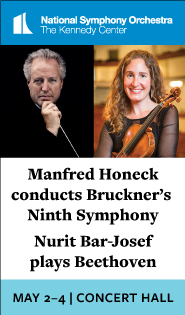Bass-baritone Tines reimagines Bach, spirituals in Vocal Arts recital

Davóne Tines was going to make his Kennedy Center debut last March, yet another career milestone delayed by the coronavirus. The bass-baritone, born in Warrenton, Virginia, ended up performing this innovative recital program for a digital camera instead. The results can be streamed starting today, the latest concert in the online series presented by Vocal Arts DC in this unusual season.
Tines, accompanied by pianist Adam Nielsen, designed this recital around the form of the Catholic Mass Ordinary. That sequence of Latin texts, presented out of order, was perhaps less a scaffolding for the musical selections than a structure to push against and resist. In a program interview with Fergus McIntosh, Tines admits it could be said that he is “queering the Mass, queering in the broad sense of bending it to my own understanding.”
Most sections of the program featured three types of music: new unaccompanied vocal miniatures by Caroline Shaw, sacred arias by J. S. Bach, and arrangements of Gospel hymns. A sense of liturgical procession arose from Tines circling between pieces to different positions around the piano, behind Nielsen for the Shaw pieces and on opposite sides for the Bach and Gospel-influenced pieces. The tenebrous nave of New York’s Church of the Heavenly Rest, at the corner of Fifth Avenue and 90th Street, provided a numinous backdrop.
The Shaw pieces set limited sections of the Latin texts of the Catholic Mass. Sometimes very limited, like the Credo piece, which featured only the first word of the Nicaean Creed, leaving unstated exactly what is believed. Unaccompanied and monophonic, these little works recalled Gregorian chant in some ways, resonating in the stone-backed acoustic.
Shaw likes to explore the range and timbre of the human voice, and in a brief space Tines featured the robust and mellow sides of his tone in the Kyrie piece. Cantillation, reminiscent of other religious traditions, appeared in Agnus Dei and Sanctus. Tines has an extraordinary vocal range, including into an extended falsetto at the top, heard in both crooning style in Sanctus and in hysterical shrieking in Credo.
Bach was least suited to Tines’s voice, which was not lithe enough for subtle parts like the runs in “Wie jammern mich doch die verkehrten Herzen” from Cantata No. 170. The longer melodic lines, in which Bach treats the voice like an instrument, led to some awkward breaths. The developed bass register of the voice came across beautifully in “Komm süßes Kreuz” from the St. Matthew Passion, a text about facing suffering with resolution that had a lot in common with the Gospel texts on the program.
Nielsen played these accompaniments with muscular authority, in textures that sounded heavy and broad like a Busoni arrangement. Tines added some ornaments in the reprise of the A section of “Mache dich, mein Herze, rein” from the St. Matthew Passion, an admirable touch, but the choice to sing parts of the tune up an octave was decidedly odd. Schmaltzy rallentandos and vocal slides sounded similarly out of place in “Quia fecit mihi magna” from the Magnificat in D.
No such reservations about the Gospel-influenced pieces, beginning with Tyshawn Sorey’s Songs for Death, recompositions of three traditional spirituals with bleak piano accompaniment redolent of post-romantic chromaticism. Tines gave the vocal part roaring fierceness, playing into the darker understanding of these traditional tunes Tines has described as “essentially code for suicide notes.” The agitated arpeggiation at the words “If you get there” in “Swing Low, Sweet Chariot” added a note of obsession with death.
Hearing these reimagined spirituals first influenced how one heard two more traditional Gospel arrangements by Moses Hogan later in the program. Tines mined ecstatic exploration of both his falsetto and deep basso ranges in “Give Me Jesus,” and “My Good Lord Done Been Here” rang with a sense of near-exasperation. “To a Brown Girl Dead,” a brief song by Margaret Bonds, once a student of Florence Price, offered a beautifully limned vignette of mourning.
The three final works moved into more mysterious territory. In his own arrangement of “Amazing Grace,” Tines walked into the darkness outside the performing space, the microphones not catching his voice directly, over a rumbling piano accompaniment. He then gave an astounding rendition of “Prelude to the Holy Presence of Joan D’Arc” by Julius Eastman, a visionary litany served perfectly by the blustery side of his voice, which grew deeper in pitch and faded out.
“Vigil,” a brief but powerful tribute to Breonna Taylor by Igee Dieudonné and arranged by Tines, brought the concert full circle into more recent troubling events. The text is a paraphrase of the Prayer of St. Francis, about spreading light when surrounded by darkness, a possible response to the saints telling Joan of Arc in the previous song, “Speak boldly when they question you.” The concluding “Hallelujah” section featured more of Tines’s dulcet falsetto, inviting the listener to soar upward with him into a realm of contemplation.
This recording can be streamed through February 1. vocalartsdc.org







